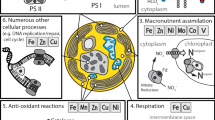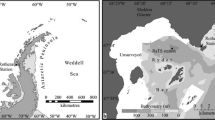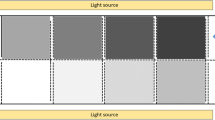Abstract
We have carried out field and laboratory experiments to examine the iron requirements of colonial Phaeocystis antarctica in the Ross Sea. In December 2003, we performed an iron/light-manipulation bioassay experiment in the Ross Sea polynya, using an algal assemblage dominated by colonial Phaeocystis antarctica, collected from surface waters with an ambient dissolved Fe concentration of ∼0.4 nM. Results from this experiment suggest that P. antarctica growth rates were enhanced at high irradiance (∼50% of incident surface irradiance) but were unaffected by iron addition, and that elevated irradiance mediated a significant decrease in cellular chlorophyll a content. We also conducted a laboratory iron dose–response bioassay experiment using a unialgal, non-axenic strain of colonial P. antarctica and low-iron (<0.2 nM) filtered seawater, both collected from the Ross Sea polynya in December 2003. By using rigorous trace-metal clean techniques, we performed this dose–response iron-addition experiment at ∼0°C without using organic chelating reagents to control dissolved iron levels. At the relatively low irradiance of this experiment (∼20 μE m−2 s−1), estimated nitrate-specific growth rate as a function of dissolved iron concentration can be described by a Monod relationship, yielding a half-saturation constant with respect to growth of 0.45 nM dissolved iron. This value is relatively high compared to reported estimates for other Antarctic phytoplankton. Our results suggest that seasonal changes in the availability of both iron and light play critical roles in limiting the growth and biomass of colonial Phaeocystis antarctica in the Ross Sea polynya.




Similar content being viewed by others
References
Anderson MA, Morel FMM (1982) The influence of aqueous iron chemistry on the uptake of iron by the coastal diatom Thalassiosira weissflogii. Limnol Oceanogr 27:789–813
Arrigo KR, van Dijken GL (2004) Annual changes in sea ice, chlorophyll a, and primary production in the Ross Sea, Antarctica. Deep-Sea Res Part II 51:117–138
Arrigo KR, Tagliabue A (2005) Iron in the Ross Sea, Part II: impact of discrete iron addition strategies. J Geophys Res 110 (C03010). DOI: 10.1029/2004JC002568
Arrigo KR, Weiss AM, Smith WO (1998) Physical forcing of phytoplankton dynamics in the southwestern Ross Sea. J Geophys Res 103(C1):1007–1022
Arrigo KR, Robinson DH, Worthen DL, Dunbar RB, DiTullio GR, VanWoert M, Lizotte MP (1999) Phytoplankton community structure and the drawdown of nutrients and CO2 in the Southern Ocean. Science 283:365–367
Arrigo KR, Worthen DL, Robinson DH (2003) A coupled ocean-ecosystem model of the Ross Sea. Part 2: iron regulation of phytoplankton taxonomic variability and primary production. J Geophys Res 108(C7):3231. DOI: 10.1029/2001JC000856
Blain S, Sedwick PN, Griffiths FB, Queguiner B, Bucciarelli E, Fiala M, Pondaven P, Treguer P (2002) Quantification of algal iron requirements in the Subantarctic Southern Ocean (Indian sector). Deep-Sea Res Part II 49:3255–3273
Boyd PW (2002) Environmental factors controlling phytoplankton processes in the Southern Ocean. J Phycol 38:844–861
Boye M, Nishioka J, Croot PL, Laan P, Timmermans KR, de Baar HJW (2005) Major deviations of iron complexation during 22 days of a mesoscale iron enrichment in the open Southern Ocean. Mar Chem 96:257–271
Brand LE, Sunda WG, Guillard RRL (1983) Limitation of marine phytoplankton reproductive rates by zinc, manganese and iron. Limnol Oceanogr 28:1182–1198
Brown MT, Landing WM, Measures CI (2005) Dissolved and particulate Fe in the western and central North Pacific: results from the 2002 IOC cruise. Geochem Geophys Geosys 6. DOI: 10.1029/2004GC000893
Coale KH, Fitzwater SE, Gordon RM, Johnson KS, Barber RT (1996) Control of community growth and export production by upwelled iron in the equatorial Pacific Ocean. Nature 379:621–624
Coale KH, Wang X, Tanner SJ, Johnson KS (2003) Phytoplankton growth and biological response to iron and zinc addition in the Ross Sea and Antarctic Circumpolar Current along 170°W. Deep-Sea Res Part II 50:635–653
Coale KH, Gordon RM, Wang X (2005) The distribution and behavior of dissolved and particulate iron and zinc in the Ross Sea and Antarctic circumpolar current along 170°W. Deep-Sea Res Part I 52:295–318
De Baar HJW, Buma AGJ, Nolting RF, Cadée GC, Jacques G, Tréguer PJ (1990) On iron limitationof the Southern Ocean: experimental observations in the Weddell and Scotia Seas. Mar Ecol Progr Ser 65:105–122
DiTullio GR, Geesey ME (2002) Photosynthetic pigments in marine algae and bacteria. In: Bitton G (ed) The encyclopedia of environmental microbiology. John Wiley & Sons, pp 2453–2470
DiTullio GR, Smith WO (1995) Relationship between dimethylsulfide and phytoplankton pigment concentrations in the Ross Sea, Antarctica. Deep-Sea Res Part I 42:873–892
DiTullio GR, Smith WO Jr (1996) Spatial patterns in phytoplankton biomass and pigment distributions in the Ross Sea. J Geophys Res 101:18467–18477
DiTullio GR, Hutchins DA, Bruland KW (1993) Interaction of iron and major nutrients controls phytoplankton growth and species composition in the tropical north Pacific Ocean. Limnol Oceanogr 38:495–508
DiTullio GR, Grebmeier JM, Arrigo KR, Lizotte MP, Robinson DH, Leventer A, Barry JP, VanWoert ML, Dunbar RB (2000) Rapid and early export of Phaeocystis antarctica blooms in the Ross Sea, Antarctica. Nature 404:595–598
DiTullio GR, Garcia NS, Riseman SF, Sedwick PN (2007) Effects of iron concentration on pigment composition in Phaeocystis antarctica. Biogeochemistry (this issue)
Eldridge ML, Trick CG, Alm MB, DiTullio GR, Rue EL, Bruland KW, Hutchins DA, Wilhelm SW (2004) Phytoplankton community response to a manipulation of bioavailable iron in HNLC waters of the subtropical Pacific Ocean. Aquat Microb Ecol 35:79–91
Fitzwater SE, Coale KH, Gordon RM, Johnson KS, Ondrusek ME (1996) Iron deficiency and phytoplankton growth in the Equatorial Pacific. Deep-Sea Res Part II 43:995–1015
Fitzwater SE, Johnson KS, Gordon RM, Coale KH, Smith WO (2000) Trace metal concentrations in the Ross Sea and their relationship with nutrients and growth. Deep-Sea Res Part II 47:3159–3179
Gerringa LJA, de Baar HJW, Timmermans KR (2000) A comparison of iron limitation of phytoplankton in natural oceanic waters and laboratory media conditioned with EDTA. Mar Chem 68:335–346
Gibson JAE, Garrick RC, Burton HR, McTaggart AR (1990) Dimethylsulfide and the alga Phaeocystis pouchetii in Antarctic coastal waters. Mar Biol 104:339–346
Gledhill M, van den Berg CMG (1994) Determination of complexation of iron(III) with natural organic complexing ligands in seawater using cathodic stripping voltammetry. Mar Chem 47:41–54
Gordon LI, Codispoti LA, Jennings JC Jr, Millero FJ, Morrison JM, Sweeney C (2000) Seasonal evolution of hydrographic properties in the Ross Sea, Antarctica, 1996–1997. Deep-Sea Res Part II 47:3095–3117
Gregg WW, Carder KL (1990) A simple spectral solar irradiance model for cloudless maritime atmospheres. Limnol Oceanogr 35:1657–1675
Guillard RRL, Hargraves PE (1993) Stichochrysis immobilis is a diatom, not a chrysophyte. Phycologia 32:234–236
Hiscock MR (2004) The regulation of primary productivity in the Southern Ocean. Ph.D. Thesis, Duke University, 174 pp
Hong Y, Smith WO, White A-M (1997) Studies on transparent exopolymer particles (TEP) produced by Phaeocystis sp. (Prymnesiophyceae) in the Ross Sea, Antarctica. J Phycol 33:368–376
Hudson RJM, Morel FMM (1989) Distinguishing between extracellular and intracellular iron in marine-phytoplankton. Limnol Oceanogr 34:1113–1120
Hutchins DA, Franck VM, Brzezinski MA, Bruland KW (1999) Inducing phytoplankton iron limitation in iron-replete coastal waters with a strong chelating ligand. Limnol Oceanogr 44(4):1009–1018
Hutchins DA, Sedwick PN, DiTullio GR, Boyd PW, Quéguiner B, Griffiths FB, Crossley C (2001) Control of phytoplankton growth by iron and silicic acid availability in the subantarctic Southern Ocean Experimental results from the SAZ project. J Geophys Res 106(C12):31559–31572
Knap A, Michaels A, Close A, Ducklow H, Dickson A (1996) Protocols for the Joint Global Ocean Flux Study (JGOFS) core measurements. JGOFS Report 19, 170 pp
Kuma K, Nishioka J, Katsuhiko M (1996) Controls on iron(III) hydroxide solubility in seawater: the influence of pH and natural organic chelators. Limnol Oceanogr 41:396–407
Kuma K, Katsumoto A, Kawakami H, Takatori F, Matsunaga K (1998) Spatial variability of Fe(III) hydroxide solubility in the water column of the northern North Pacific Ocean. Deep-Sea Res Part I 45:91–113
Liu X, Millero FJ (2002) The solubility of iron in seawater. Mar Chem 77:43–54
Maldonado MT, Price NM (1999) Utilization of iron bound to strong organic ligands by plankton communities in the subarctic Pacific Ocean. Deep-Sea Res Part II 46:2447–2473
Maldonado MT, Price NM (2001) Reduction and transport of organically bound iron by Thalassiosira oceanica (bacillariophyceae). J Phycol 37:298–310
Maldonado MT, Strzepek RF, Sander S, Boyd PW (2005) Acquisition of iron bound to strong organic complexes, with different Fe binding groups and photochemical reactivities, by plankton communities in Fe-limited subantarctic waters. Global Biogeochem Cycles 19. DOI: 10.1029/2005GB002481
Martin JH, Fitzwater SE, Gordon RM (1990) Iron deficiency limits plankton growth in Antarctic waters. Global Biogeochem Cycles 4:5–12
Matrai PA, Vernet M, Hood R, Jennings A, Brody E, Saemundsdottir S (1995) Light dependence of carbon and sulfur production by polar clones of the genus Phaeocystis. Mar Biol 124:157–167
Mathot S, Smith WO Jr, Carlson CA, Garrison DL (2001) Estimate of Phaeocystis sp. carbon biomass: methodological problems related to the mucilaginous nature of the colonial matrix. J Phycol 36:1049–1056
Measures CI, Yuan J, Resing JA (1995) Determination of iron in seawater by flow injection analysis using in-line preconcentration and spectrophotometric detection. Mar Chem 50:3–12
Moisan TA, Mitchell BG (1999) Photophysiological acclimation of Phaeocystis antarctica Karsten under light limitation. Limnol Oceanogr 44:247–258
Nakabayashi S, Kuma K, Sasaoka K, Saitoh S, Mochizuki M, Shiga N, Kusakabe M (2002) Variation in iron(III) solubility and iron concentration in the northwestern North Pacific Ocean. Limnol Oceanogr 47:885–892
Olson RJ, Sosik HM, Chekalyuk AM, Shalapyonok A (2000) Effects of iron enrichment on phytoplankton in the Southern Ocean during late summer: active fluorescence and flow cytometric analyses. Deep-Sea Res Part II 47:3179–3200
Palmisano AC, SooHoo JB, SooHoo SL, Kottmeier ST, Craft LL, Sullivan CW (1986) Photoadaptation in Phaeocystis pouchetii advected beneath annual sea ice in McMurdo Sound, Antarctica. J Plankton Res 8:891–906
Raven JA (1990) Predictions of Mn and Fe use efficiencies of phototrophic growth as a function of light availability for growth and C assimilation pathway. New Phytol 116:1–17
Robinson DH, Arrigo KR, DiTullio GR, Lizotte MP (2003) Evaluating photosynthetic carbon fixation during Phaeocystis antarctica blooms. In: DiTullio GR, Dunbar RB (eds) Biogeochemistry of the Ross Sea. Antarct Res Ser 78:77–91
Rue EL, Bruland KW (1995) Complexation of iron(III) by natural organic ligands in the Central North Pacific as determined by a new competitive ligand equilibration/adsorptive cathodic stripping voltammetric method. Mar Chem 50:117–138
Rue EL, Bruland KW (1997) The role of organic complexation on ambient iron chemistry in the equatorial Pacific Ocean and the response of a mesoscale iron addition experiment. Limnol Oceanogr 42:901–910
Schoemann V, Becquevort S, Stefels J, Rousseau V, Lancelot C (2005) Phaeocystis blooms in the global ocean and their controlling mechanisms: a review. J Sea Res 53:43–66
Sedwick PN, DiTullio GR (1997) Regulation of algal blooms in Antarctic shelf waters by the release of iron from melting sea ice. Geophys Res Lett 24:2515–2518
Sedwick PN, Edwards PR, Mackey DJ, Griffiths FB, Parslow JS (1997) Iron and manganese in surface waters of the Australian subantarctic region. Deep-Sea Res Part I 44:1239–1253
Sedwick PN, DiTullio GR, Mackey DJ (2000) Iron and manganese in the Ross Sea, Antarctica: seasonal iron limitation in Antarctic shelf waters. J Geophys Res 105(C5):11321–11336
Sedwick PN, Blain S, Queguiner B, Griffiths FB, Fiala M, Bucciarelli E, Denis M (2002) Resource limitation of phytoplankton growth in the Crozet Basin, Subantarctic Southern Ocean. Deep-Sea Res Part II 49:3327–3349
Sedwick PN, Church TM, Bowie AR, Marsay CM, Ussher SJ, Achilles KM, Lethaby PJ, Johnson RJ, Sarin MM, McGillicuddy DJ (2005) Iron in the Sargasso Sea (Bermuda Atlantic Time-series Study region) during summer: Eolian imprint, spatiotemporal variability, and ecological implications. Global Biogeochem Cycles 19. DOI: 10.1029/2004GB002445
Smith WO Jr, Gordon LI (1997) Hyperproductivity of the Ross Sea (Antarctica) polynya during austral spring. Geophys Res Lett 24:233–236
Smith WO, van Hilst CM (2003) Effects of assemblage composition on the temporal dynamics of carbon and nitrogen uptake in the Ross Sea. In: DiTullio GR, Dunbar RB (eds) Biogeochemistry of the Ross Sea. Antarct Res Ser 78:197–208
Smith WO Jr, Codispoti LA, Nelson DM, Manley T, Buskey EJ, Niebauer HJ, Cota GF (1991) Importance of Phaeocystis blooms in the high latitude ocean carbon cycle. Nature 352:514–516
Smith WO, Marra J, Hiscock MR, Barber RT (2000) The seasonal cycle of phytoplankton biomass and primary productivity in the Ross Sea, Antarctica. Deep-Sea Res Part II 47:3119–3140
Smith WO Jr, Dennett MR, Mathot S, Caron DA (2003) The temporal dynamics of the flagellated and colonial stages of Phaeocystis antarctica in the Ross Sea. Deep-Sea Res Part II 50:605–617
Soria-Dengg S, Horstmann U (1995) Ferrioxamines B and E as iron sources for the marine diatom Phaeodactylum tricornutum. Mar Ecol Progr Ser 127:269–277
Stefels J, van Leeuwe MA (1998) Effects of iron and light stress on the biochemical composition of antarctic Phaeocystis sp. (prymnesiophyceae). I. Intracellular dmsp concentrations. J Phycol 34:486–495
Sunda WG, Swift DG, Huntsman SA (1991) Low iron requirement for growth in oceanic phytoplankton. Nature 351:55–57
Sunda WG, Huntsman SA (1995) Iron uptake and growth limitation in oceanic and coastal phytoplankton. Mar Chem 50:189–206
Sunda WG, Huntsman SA (1997) Interrelated influence of iron, light and cell size on marine phytoplankton growth. Nature 390:389–392
Sweeney C (2003) The annual cycle of surface CO2 and O2 in the Ross Sea: a model for gas exchange on the continental shelves of Antarctica. In: DiTullio GR, Dunbar RB (eds) Biogeochemistry of the Ross Sea. Antarct Res Ser 78:295–312
Sweeney C, Smith WO, Hales B, Hansell DA, Carlson CA, Codispoti LA, Gordon LI, Millero FJ, Takahashi T (2000) Nutrient and TCO2 uptake and export ratios in the Ross Sea. Deep-Sea Res Part II 47:3395–3422
Tagliabue A, Arrigo KR (2005) Iron in the Ross Sea, Part I: impact on CO2 fluxes via variation in phytoplankton functional group and non-Redfield stoichiometry. J Geophys Res 110(C03009). DOI: 10.1029/2004JC002531
Tang D, Morel FMM (2006) Distinguishing between cellular and Fe-oxide-associated trace elements in phytoplankton. Mar Chem 98:18–30
Timmermans KR, Gerringa LJA, De Baar HJW, van der Wagt B, Veldhuis MJW, De Jong JTM, Croot PL (2001) Growth rates of large and small Southern Ocean diatoms in relation to availability of iron in natural seawater. Limnol Oceanogr 46:260–266
Timmermans KR, van der Wagt B, de Baar HJW (2004) Growth rates, half-saturation constants, and silicate, nitrate, and phosphate depletion in relation to iron availability of four large, open-ocean diatoms from the Southern Ocean. Limnol Oceanogr 49:2141–2151
Tovar-Sanchez A, Sanudo-Wilhelmy SA, Garcia-Vargas M, Weaver RS, Popels LC, Hutchins DA (2003), A trace metal clean reagent to remove surface-bound iron from marine phytoplankton. Mar Chem 82:91–99
Twining BS, Baines SB, Fisher NS, Maser J, Vogt S, Jacobsen C, Tovar-Sanchez A, Sanudo-Wilhelmy SA (2003) Quantifying trace elements in individual aquatic protist cells with a synchrotron X-ray fluorescence microprobe. Anal Chem 75:3806–3816
Van den Berg CMG (1995) Evidence for organic complexation of iron in seawater. Mar Chem 50:139–157
Van Hilst CM, Smith WO (2002) Photosynthesis/irradiance relationships in the Ross Sea, Antarctica and their control by phytoplankton assemblage composition and environmental factors. Mar Ecol Progr Ser 226:1–12
Van Leeuwe MA, Stefels J (1998) Effects of iron and light stress on the biochemical composition of Antarctic Phaeocystis sp. (Prymnesiophyceae). II. Pigment Composition. J Phycol 34:496–503
Wells ML (1999), Manipulating iron availability in nearshore waters. Limnol Oceanogr 44:1002–1008
Wells ML, Price NM, Bruland KW (1994) Iron limitation and the cyanobacterium Synechococcus in equatorial Pacific waters. Limnol Oceanogr 39:1481–1486
Worthen DL, Arrigo KR (2003) A coupled ocean-ecosystem model of the Ross Sea. Part 1: Interannual variability of primary production and phytoplankton community structure. In: DiTullio GR, Dunbar RB (eds) Biogeochemistry of the Ross Sea. Antarct Res Ser 78:93–105
Wu J, Luther GW III (1995) Complexation of Fe(III) by natural organic ligands in the Northwest Atlantic Ocean by a competitive ligand equilibration method and a kinetic approach. Mar Chem 50:159–177
Wu J, Boyle E, Sunda W, Wen L-S (2001) Soluble and colloidal iron in the oligotrophic North Atlantic and North Pacific. Science 293:847–849
Zivin JA, Waud DR (1982) How to analyze binding, enzyme and uptake data: the simplest case, a single phase. Life Sci 30:1407–1422
Acknowledgements
The authors gratefully acknowledge the officers and crew of the RV Nathaniel B. Palmer, and Raytheon Polar Services Company personnel for their outstanding support in the field. We thank two anonymous reviewers for their helpful criticisms and suggestions. This work has benefited from discussions with Veronique Schoemann, Walker Smith, and Alessandro Tagliabue. Funding for this research was provided by US National Science Foundation grants OPP-0230559 (PNS), OPP-0230513 (GRD) and DGE-0139313 (NSG through M. Vansickle and G. Tempel).
Author information
Authors and Affiliations
Corresponding author
Rights and permissions
About this article
Cite this article
Sedwick, P.N., Garcia, N.S., Riseman, S.F. et al. Evidence for high iron requirements of colonial Phaeocystis antarctica at low irradiance. Biogeochemistry 83, 83–97 (2007). https://doi.org/10.1007/s10533-007-9081-7
Received:
Revised:
Accepted:
Published:
Issue Date:
DOI: https://doi.org/10.1007/s10533-007-9081-7




